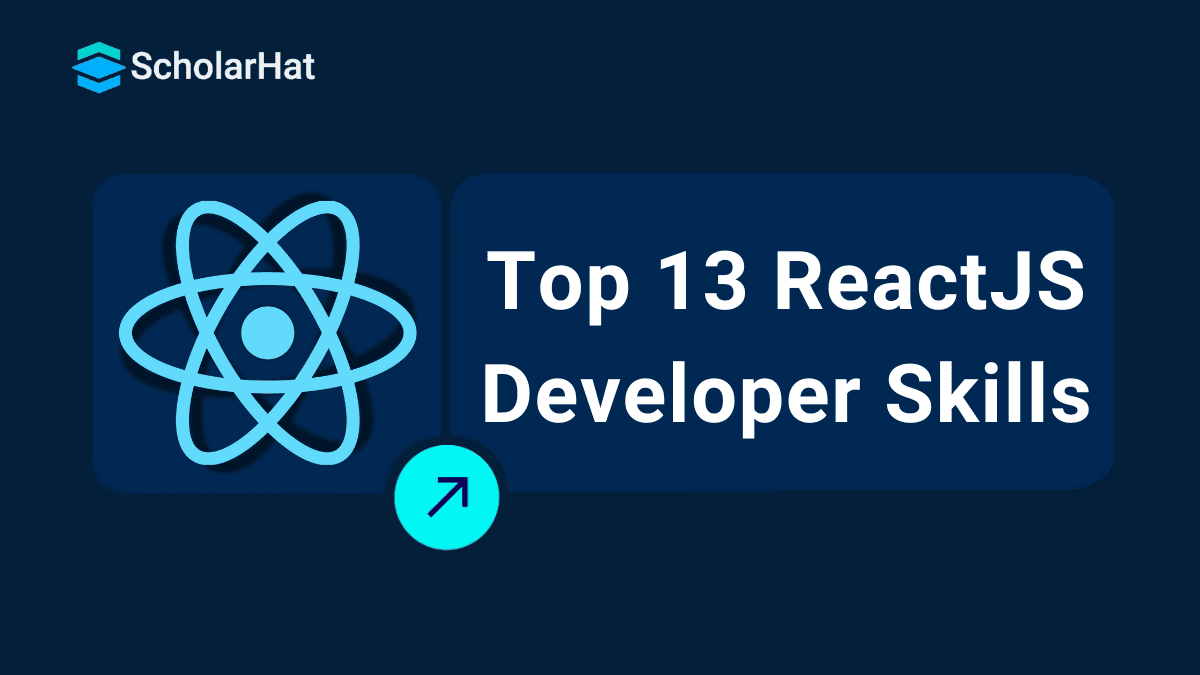26
DecTop 13 ReactJS Developer Skills to Get You Hired in 2025
React JS Developer Skills: An Overview
React offers an effective way to create responsive web applications, making it a top choice for front-end developers in 2021 and beyond. The need for React developer skills is growing. It is a browser-based library that enables building reusable web applications with unique HTML elements. React is an excellent tool for creating feature-rich applications since it excels at creating dynamic user interfaces. Hiring competent
In this article, we'll learn about React JS developer skills and React developer skills. Mastering React.js opens doors to remote jobs and global opportunities. Don’t wait—enroll in our Free React Course now and get started!
Benefits of React JS Skills
- ReactJS is a renowned platform highly useful for front-end developers.
- With the help of React JS, it becomes simpler to develop dynamic web applications.
- It demands less coding and appropriate functioning of a program that is otherwise complex.
- React JS effectively improves the performance and increases the speed of web applications.
- It effortlessly updates diverse components that are conventional in web applications.
- Moreover, it assists in building blocks and web application platforms incorporating multiple components.
- The corresponding unidirectional flow functions with several other components.
- Learning React JS helps you to debug the development of mobile and web applications.
Read More - Top 50 React Interview Question & Answers
Technical Skills of React JS Developer
Being the most widely used client-side programming technology worldwide, React necessitates a certain set of skills. To utilise React.js to its greatest potential in your projects, have a look at this list of technical React developer abilities.
1. HTML and CSS
- The important skills to take into account are HTML and CSS.
- The candidate's aptitude for design is revealed by their expertise with these client-side frameworks and crucial React JS development tools.
- For instance, a web application's expected value and quality are determined by its user interface.
- The knowledge of a React JS developer may indirectly influence the same.
2. The basics of JavaScript
- The most important skill for developers to possess is JavaScript.
- As a result, it's crucial to evaluate their knowledge of JavaScript's foundational concepts, including code structure, variables, data types, arrays, and more.
- As a result, if they possess a solid foundational knowledge.
- Their expertise in coding will be useful in creating a high-performance program.
3. JavaScript ES6
- A developer for React JS must also be knowledgeable about ES6.
- Based on the requirements of the client, programmers can create and maintain web apps using this version of JS.
- High-order functions, event handling, arrow functions, DOM manipulation, and other ES6 features are the most useful for React JS developers.
4. JavaScript XML (JSX)
- JSX, a syntactic extension for JavaScript, allows for more comfortable coding.
- Developers skilled in JSX can rapidly code and integrate HTML/XML elements into React.
- With this knowledge, React developers may quickly design applications using React APIs instead of spending hours on tedious tasks.
- JSX is used to accelerate and simplify app development while enhancing app scalability without complicating the code.
5. Variables and Scope
- knowing when and where you can access the information you need.
- JavaScript's variables provide a means for developers to store data in memory and then access that data through our programs.
6. Git
- When it comes to saving and preserving code versions, the Git toolkit experts are masters.
- The project can be maintained by developers with these skills on centralized version control systems like GitHub, Bit Bucket, and GitLab.
- By using commands like push, pull, remark, add, etc., programmers can edit the code as necessary.
- Git records these modifications.
- Additionally, it gives programmers the ability to mix and isolate modules to evaluate how the code performs in various contexts.
7. Event Handling Facility and DOM
- The term "DOM Manipulation" describes the process of altering a node's value or including a new node in the document tree.
- The online user interface is impacted by changes to the DOM. This process is called rendering.
- One skill required of React developers is the capacity to alter objects and the values of their attributes.
- React controls the system with the help of the convenient function setState().
Read More - React developer salary in India
8. Node + npm
- Node can be a requirement if you want to recruit a full-stack React JS engineer.
- The requirements for client-side development may be properly understood by a React JS developer who is proficient with nodes.
- Additionally, developers need to be completely familiar with the Node Packet Manager registry.
- It facilitates the restructuring of app bundles and the separation of additional React library functionality.
9. Redux
- Asynchronous state updates are one of the drawbacks of React development projects.
- Understanding and using Redux is therefore one of the skills most required for creating React JS projects.
- The React framework may be managed and kept in check by a programmer.
- Redux, an internal state, is grateful. ReactJS developers can utilize it for state management.
- Redux helps programmers build applications that behave consistently, are easy to test, and work equally well in a variety of settings.
10. Fetch data from both GraphQL and Rest APIs
- React JS is a front-end framework for building online applications, and it has the ability to obtain data from the back end.
- Additionally, a well-liked method of getting data from the back end is using the rest API with GraphQL.
- In order to retrieve the data using these APIs, react.js developer skills will be useful.
Top 3 React JS Developer Soft Skills to Screen When Hiring
1. Excellent Communication
- Consistent communication is essential to the development process, both inside the team and with clients.
- Having a developer with effective communication skills is, therefore, necessary to involve others in sharing progress updates.
- It's crucial to comprehend the requirements of the project and the development of the app, to explain those requirements to other team members, etc.
2. Problem-Solving Approach
- The candidate's capacity for logical thought, comprehension, and reasoning affects their approach to problem-solving.
- The efficiency with which coders move from detecting a problem to identifying a solution serves as a gauge of the project's success.
- A developer may deal with any problem, even an unintended mistake that occurs during the creation of an app.
- He must be the one who has a proven approach to solving problems.
- You must therefore pick a candidate who is daring enough to think creatively beyond the box. He ought to be prepared to make errors and learn from them.
3. Ability to Work in a Team
- The React JS development community is not made up of lone wolves prowling the wilderness.
- But even developers who fully grasp the extensive feature set of React JS must collaborate with team members.
- Clients, designers, and testers are all part of it. So, in order to cooperate and communicate with other team members, React JS programmers must create a persona.
4. Accountability
- When you establish objectives and due dates for your tasks, you are being accountable at work.
- Simply take the initiative and spell out exceptions in detail.
- You are in charge of the operation and well-being of the business as a React developer.
- You are also accountable for its customers and the user experience they have.
- This obligation goes beyond the actual coding.
Summary
In recent times, React has become one of the most extensively used frameworks for software developers to develop engaging applications. Owing to its high demand, React developers are expected to have extraordinary skills.
React.js is powering apps like Netflix and Instagram. Don’t miss out—join our React JS Online Course and build world-class projects!
FAQs
Take our React skill challenge to evaluate yourself!

In less than 5 minutes, with our skill challenge, you can identify your knowledge gaps and strengths in a given skill.











